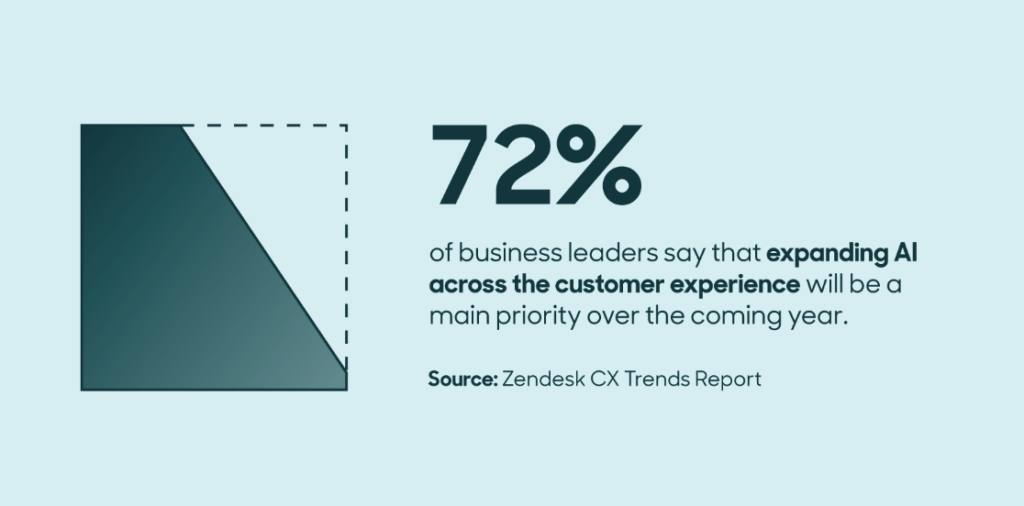Filters
Content Type
Topic
6 Benefits of Workflow Automation for Technology Companies
Inspector Gadget was a famous childhood cartoon about a detective who could immediately produce any tool he needed. These tools allowed him to accomplish dozens of tasks, no matter the situation.
While you may not have a hat that produces helicopter wings or gloves with screwdrivers, AI is your tools set, ready to jump in when you need it. If you establish a workflow, you won’t need to manually start the tools as they’ll run automatically, saving you the time and energy that those menial tasks would have otherwise used.
Learn six benefits of workflow automation for technology companies that want to prepare their companies for growth.

1. Build a Positive Customer Experience
Over half of customers would switch brands over just one negative experience. To say customer experience is essential is an understatement. That’s why business leaders are finding new ways to ensure customers receive the experience they want and need.
AI has played an instrumental role in transforming the customer experience. An estimated 72% of business leaders will prioritize AI in the customer experience over the next year.

Image from Zendesk
Here are a few benefits of using AI workflow automation in the customer experience.
Consistency
Workflows move automatically, creating consistent results for customers and your business. Marketing workflow management establishes the rules for creating that consistency.
You also help improve consistency by creating clear guidelines when each team enters the marketing automation. For instance, sales know precisely when it’s their turn to step in with a lead to convert them, so there’s no communication gap.
Personalized Marketing Campaigns
For technology companies, engaging customers through personalized campaigns is essential as most technology companies use account-based marketing to reach their B2B clients.
Workflow automation creates a personalized marketing automation workflow without you having to interfere manually. By automating lead nurturing, segmentation, and content delivery, you can deliver targeted messages that resonate with each audience, ultimately improving the customer experience.
Proactive Customer Support
You probably don’t have the staff required to support customers constantly. However, automated workflows take that load from your team’s shoulder.
Customer support automated workflows streamline issue resolution processes. You can use AI chat support or automated email responses to customer questions.
Technology companies can also provide proactive support through automated ticketing, routing, and responses. These strategies improve customer satisfaction and free up support teams to focus on more complex issues.
Data-Driven Customer Insights
Automation tools gather valuable data throughout the customer journey. You can use this data to discover actionable insights into customer behavior, preferences, and pain points.
By leveraging these insights, you can refine your strategies for each customer, create tailored experiences, and build lasting customer relationships.
For example, Hushly uses first-party data to create customized content recommendations based on user behavior, so each website visitor has a unique experience.
2. Operate with Greater Efficiency
Efficiency and productivity directly reflect how well your team is operating. When productivity is high, you’re maximizing your resources and time.
Here are a few ways workflow automation helps you reach greater efficiency and productivity.
Streamlined Processes
Workflow automation significantly reduces manual interventions in repetitive tasks.
Do you send the same email to all new leads? There’s no need to add them to a list and manually send it. Just automate the welcome email.
Technology companies can streamline most of their operations by automating routine processes, allowing teams to focus on high-value activities.
Task Prioritization and Optimization
Automation tools enable technology companies to prioritize tasks based on importance and urgency.
By optimizing task sequences, teams can ensure they complete critical processes first, contributing to overall productivity.
This strategic prioritization also helps the team change with differing project requirements, so they always focus on the most critical tasks first.
3. Improve Company Collaboration
Collaboration and communication can make or break a team. If you have effective communication, you can increase your productivity by 25%. Here are a few ways workplace automation helps with better collaboration and communication.
Cross-Functional Collaboration
Collaboration across diverse teams – from development and marketing to sales and customer support – is essential in any efficient business to perform larger strategies.
Workflow automation supports cross-functional cooperation by providing a centralized communication and project management platform. This enhanced collaboration breaks down silos and promotes a culture of transparency and shared goals.
Real-Time Visibility
Automation tools offer real-time visibility into project statuses and team activities. This transparency allows stakeholders to track progress, identify bottlenecks, and make data-driven decisions.
Real-time insights enable teams to respond promptly to challenges that might arise. This prompt response ensures that projects stay on course.
Customer-Focused Workflows
Automation allows companies to create customer-focused processes, from lead generation to post-sale support. Companies can enhance customer satisfaction, loyalty, and retention by aligning workflows with customer needs.
4. Increase Your Company’s Scalability
Your scalability is your ability to grow or handle differing workloads. When you complete everything manually, you limit yourself to your abilities. However, adding workflow automation allows you to handle nearly endless tasks without adding time to your schedule.
Here are some specific examples of workflow automation’s benefits to your company’s scalability.
Adaptability to Growth
Technology companies often experience rapid growth and evolving business needs.
Workflow automation provides the scalability required to handle increased workloads seamlessly.
You can quickly adapt and scale automated processes to accommodate growing demands, ensuring that you maintain operational efficiency even during expansion.
Resource Optimization
As technology companies scale, optimizing resources becomes crucial to ensure you have enough resources to handle every growth stage.
Workflow automation enables efficient resource use by automating resource-intensive tasks. This optimization ensures that you direct valuable human resources toward the most strategic areas first.
Integration with Existing Systems
There’s no need to add yet another software to your already complicated system.
Workflow automation, like Hushly, seamlessly integrates with existing systems and tools. This flexibility allows technology companies to leverage automation without disrupting their current workflows.
Adaptability and an agile workflow are particularly beneficial as companies evolve and adopt new technologies, ensuring a smooth transition.
5. Build a Network for Accountability
Security and privacy are top priorities for tech companies that operate so extensively online. Workflow automation makes this overwhelming task just a little easier.
Data Governance and Compliance
Workflow automation allows you to stay on top of all the latest data governance policies.
By automating data management processes, you can reduce non-compliance risk and safeguard sensitive information.
You also reduce the risk of errors since you’ll have minimal human intervention.
Security Protocols
Automation workflow tools often come equipped with advanced security features. These features include encryption, access controls, and audit trails to protect sensitive data.
Implementing automated security protocols ensures that technology companies can maintain data confidentiality and integrity.
6. Reduce Costs While Maximizing Your ROI
Let’s talk about the financial return. After all, no strategy is worth adopting unless it positively impacts your profits. Here are a few ways to save more while boosting your earnings through workflow automation.
Operational Cost Optimization
Automation reduces the need for manual labor in repetitive tasks. This leads to operational cost savings since you have an employee who works for free doing functions that most people don’t enjoy.
Resource Allocation Optimization
By automating resource-intensive tasks, technology companies can optimize resource allocation.
Whether human or computing resources, automation ensures you use these assets strategically, minimizing waste.
Faster ROI on Technology Investments
Implementing workflow automation speeds up the time between closing a sale and receiving payment. That, in turn, means you’ll have a healthy cash flow and a higher return on investment (ROI).
The improved efficiency, productivity, and streamlined processes contribute to faster returns, making technology initiatives the best financial choice.
Boost Your Workplace Efficiency Through Workflow Automation
Efficiency is just the tip of the iceberg for workplace automation benefits. It offers a complete system supporting you in every stage of marketing and conversion. You’ll soon be running like a well-oiled machine through workplace automation, allowing you to move faster and smoother through the conversion process.
Hushly is your all-in-one conversion cloud with every tool you need to build this workflow automation machine. It’s fully customizable to your business and customers, allowing you to gain every benefit.
Schedule a demo to see the power of Hushly’s workflow automation for yourself.
The post 6 Benefits of Workflow Automation for Technology Companies appeared first on Hushly.



